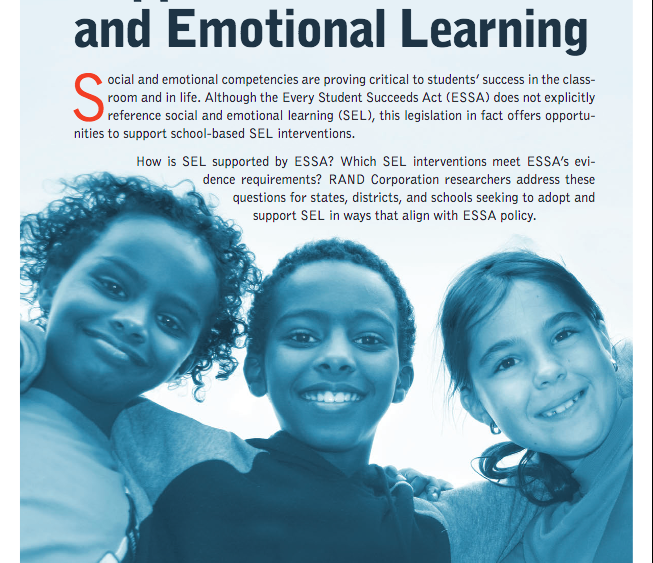 |
Since the Every Student Succeeds Act (ESSA) originally passed in December 2015, afterschool partners have been able to use their expertise in youth development to build on the newfound flexibility that ESSA provides for states, districts, and schools around the country toward the goal of well-rounded support for all students. An especially promising avenue for the field is the new opportunities that have arisen around social and emotional learning (SEL). Numerous studies have shown that social and emotional learning can support many areas of student development and achievement, but there have historically been few opportunities to advance SEL through the formal education system. While ESSA does not explicitly mention SEL, there is a strong case to be made that the bill provides a wealth of new opportunities to advance SEL interventions both in and out of school.
On December 13, RAND researchers in coordination with researchers at the Wallace Foundation hosted a webinar highlighting how SEL interventions fit into the structure of ESSA. Focusing largely on the findings of the RAND Corporation’s recently published brief, “How the Every Student Succeeds Act Can Support Social and Emotional Learning,” presenters shared some good news: RAND has identified a menu of 60 SEL interventions that meet the requirements laid out by ESSA.
The new report discusses the fact that ESSA’s “policy language includes calls for improving school conditions for student learning; enhancing peer interactions; providing a well-rounded education; and incorporating programs and activities that promote volunteerism, community involvement, or instructional practices for developing relationship-building skills.” Consequently, the research looks across numerous studies in the context of ESSA, considering first the portions of the law in which social and emotional learning might play a substantial and meaningful role. ESSA contains nine titles (sections), and while many touch on SEL in some component, the brief highlights three that offer substantial opportunities to incorporate SEL:
- Title I: Improving the Academic Achievement of the Disadvantaged
- Title II: Preparing, Training, and Recruiting High-Quality Teachers, Principals, or Other School Leaders
- Title IV: 21st-Century Schools (which includes 21st CCLC, Promise Neighborhoods, Community schools, and a new block grant – the Student Support and Academic Enrichment Grant
ESSA gives states and districts new flexibility to choose how to support struggling schools and students, but requires that the interventions funded under the law, such as those focused on school improvement, have a solid evidence base (U.S. Department of Education guidance further details the specific evidence “tiers” that meet the law’s standard). To that end, the researchers looked across available interventions designed to improve outcomes in social and emotional learning.
The brief and complementary Evidence Review report identify 60 interventions which both meet the evidence required in ESSA and can be supported by one or more of the Titles listed above. Six of the studies identified included an out-of-school time component. The interventions identified often yielded positive impacts on interpersonal relationships and intrapersonal competencies, and many also had positive effects on academic achievement, behavior, and school climate.
One of the researchers’ recommendations is that educators and policymakers use the flexibility in areas like Title IV to keep researching new innovations in the SEL space. Researchers also recommended the continuation of work to improve the measurement of social and emotional competencies.
Youth development professionals in out-of-school time can begin by looking at the table of interventions listed in the Evidence Review. They may also consider linking with local universities, research institutions, or regional educational laboratories to develop research around the interventions they are currently employing for youth so that the list of successful interventions can continue to grow. Finally, they can continue to build on the dialog about how useful these skills are in the development of all youth and remind schools and partners that children benefit from a full set of skills — including but not limited to academics — to help navigate and interpret themselves, their communities, and the world.

Comments are closed.